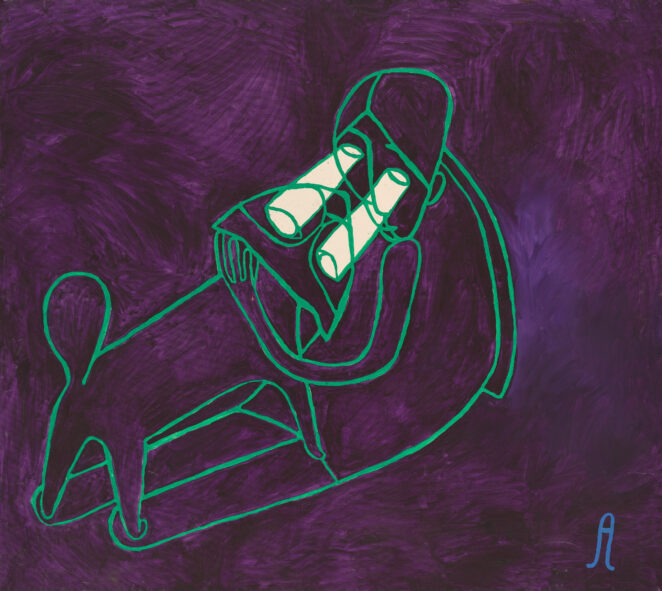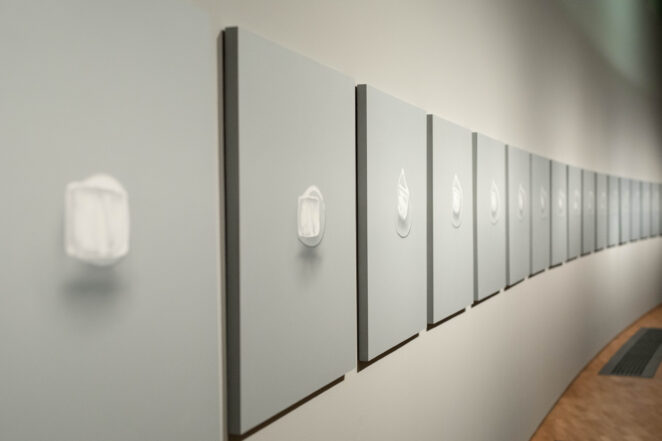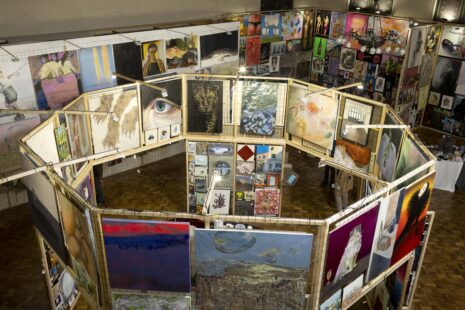Interest in politics has always played a significant role in my life, and in later years this certainly influenced also my perception of art. In the late 1980s, I was a student at Riga Industrial Polytechnic. My student years coincided with a time of political change, and together with my fellow students, I took part in the January 1991 barricades in Riga’s Old Town. I was also active in the youth organization of the Latvian Popular Front. These events were also decisive in my later turn to politics.
In 1992, I entered the newly established Faculty of Political Science at the University of Latvia. In the 1980s, students at the University of Latvia still had to take a compulsory course in Marxism-Leninism, but we were the very first students who had the opportunity to study the principles of Western democracy and the market economy. Lessons were also taught in foreign languages, and professors from Western universities were also invited to work at the university as teaching staff.
Since the rapid transition from a socialist system to democracy and a market economy began in Latvia after the restoration of independence, such professional education based on Western knowledge was in great demand at that time.
In parallel with my studies at the university, I engaged political activities and at the age of 23 I was elected a member of parliament, but already at 27 I became the youngest-ever minister in the history of the Latvian government – the Minister of Education and Science. Together with my wife Irina, we became more interested in art after the turn of the millennium, when, after an active political career I turned to entrepreneurship. Our common interest in contemporary art has developed from a much broader interest in contemporary culture as a whole, which in addition to visual art includes music, theatre, literature, architecture, cinema, and other arts. We have been active participants in various cultural projects over the last twenty years and since then have deliberately not limited ourselves to any one particular field of art.

Antanas Sutkus (Lithuania). Goodbye, Party Comrades! Vilnius. 1991. Black and white digital print. Vitols Contemporary Art Collection
Another part of your interest is the cultural diversity of the region which is represented in the exhibition by artworks from such countries as Latvia, Romania, Poland, Russia, Czechia, Lithuania, Estonia, Georgia, Slovakia, Albania and Ukraine. How would you compare them? Could you say that some of them are more radical or conservative than others?
When we chose the focus of our collection – contemporary art from Eastern and Central Europe after 1989 – we realized that we would try to trace the transformation process and all the political, social, and cultural changes in the region. In the context of our collection, we must consider that the East-Central European region has never historically been a homogenous structure, and there have always been great cultural and value differences within it.
After an initial phase of democratization in the early 1990s countries in the region started to part ways. Most of them experienced a strong aspiration toward Western political systems and therefore continued to further implement the chosen model, but, for example, the political regimes of Russia and Ukraine began to change their affiliation toward authoritarianism. In Putin’s Russia, autocratization was fully implemented, but Ukraine returned to democratic choice.
In the second decade of the 21st century, the trend of democratization begins to lose momentum in Central Europe as well.
Although the Baltic States have been able to maintain their liberal democratic quality, Poland, Hungary, Slovenia and a number of other countries in the region have begun to lose it. We can see that the values of democracy in these countries are undefended, they are not alive, and they are not irreversibly entrenched in the public consciousness. Democratic values still need to be fought for and defended.
In many Central European countries, there are attacks not only on the free press, but also on the autonomy of educational and cultural institutions. In Poland, for example, in many cases professionals in the management of state-run museums are being replaced by puppets who are obedient to the ruling politicians and then censor the museums’ exhibition programs; meanwhile, artists actively participate in political demonstrations. Contemporary art from our collection is partly reflecting also these changes in politics, culture, and value orientation in the region.

Vladimir Arkhipov (Russia). Genady Vladimirovich’s Bathub-Bed. 2001. Mixed media. Vitols Contemporary Art Collection
As the reader can notice, Russia is on the list, too, and I guess we cannot proceed without talking about the Ukrainian war… In the current situation many institutions are making gestures related to it: banning Russian athletes, expelling ambassadors, etc. Are Russian art and artists somehow „saved“ from this fate or still not?
More than 30 years after the fall of the Berlin Wall, the region is once again the focus of global attention, due to the Russian genocide in Ukraine. The war in Ukraine will completely isolate Russia and Belarus from the rest of the region for many decades, and we are likely to see a new political iron curtain descending and severing all cultural relations with these two countries. My opinion is also that the so-called watershed for cultural cooperation in a war situation is a public and explicit condemnation of Putin’s criminal regime by the Russian artists concerned.
By now we have identified all the Russian artists in our collection who openly condemn Russia’s war in Ukraine. This is, in our view, a prerequisite for their work to be publicly exhibited. For example, all the Russian artists whose works from our collection are currently on show at Kumu.
You are Latvian – what is the approximate percentage of Latvian authors in your collection? Do you „treat“ them somehow differently than artists from other countries and who are your personal favorites?
In the first years of collecting, the main attention was paid to Latvian art, gradually involving it in a dialogue with the works of Estonian and Lithuanian artists. Then a decision was taken to expand the geography and include other countries in the Eastern European region. The Vitols Contemporary collection now represents more than 1 000 works of art by 150 artists from 20 Eastern and Central European countries, including about 40 Latvian artists. Approximately 15% of the collection is on show at the KUMU.
I’m on „very thin ice” if you are asking to name my personal favorite contemporary artists from Latvia. It is very difficult to single out only a few Latvian artists in our collection so that others do not get offended that they are not mentioned. It is also very difficult to compare the artists representing different generations. At some point, we will create the home page of the collection, and then everything will be visible. But if you insist so, then let there be, for example, Aija Zarina and Kristaps Gelzis – both of them for sure would deserve solo exhibitions at some Estonian art museum one day.

Aija Zarina (Latvia). Zuzanna and the Cat.1998. Oil on canvas. Vitols Contemporary Art Collection
And, of course, I wish to ask about Estonian artists in your collection – including Tõnis Saadoja and Alice Kask amongst others. In my own opinion, the creation of both of them is very aesthetic, the consistency and filigranity of their working style is physically tangible. But what is that charms you about them? Or about some other Estonian artist?
I don’t want you to get the wrong idea about our collection – it is not consisting only of politically or socially very motivated art, open and direct manifestations of critical ideas. The selection of artworks doesn’t necessarily reflect the current features of our time, but mostly reveals our own subjective taste as collectors, our sense of humor, the different facets of our personalities, demonstrates our diverse interests and values, and tells stories that are important to us.
For example, in the case of works by Tõnis Saadoja and Alice Kask on view at the exhibition in KUMU – they even can’t be interpreted in a specific temporal and spatial context. For me, these works create a feeling of a specific tension, a kind of melancholic atmosphere that invites us to some metaphysical levels of timelessness. Or, for example, let’s take some of the works by Estonian artist Kaido Ole in our collection. Ole gives himself to a free flow of ideas, lightness of expression and playfulness in his art. His works are also often supplemented by an ironical observation as in his work „At the Art Exhibition“. For every artwork in the collection, there is a different reason why we appreciate it.

Tõnis Saadoja (Estonia). The Melting of an Ice Cube. 2003. 20 oil paintings on HDF. Exhibition view at the KUMU Art Museum. Photo by Maris Raud
It caught my eye how in one exhibition room there was depicted the melting process of an ice cube (Tõnis Saadoja) during a rather long time; while in the other, in contrast, there was a series of views from a window of a moving train (Olga Chernysheva) during a brief moment. How would these two examples, separately or together, illustrate the essence of a memory which is the theme of the exhibition? Could we say that sooner or later, memories will melt, or that they are passing by just like a blink of an eye?
The exhibition „Archaeologists of Memory“ is brilliantly curated by Eda Tuulberg and the installation is designed by Anna Škodenko. The conceptual focus chosen by curator is different mnemonic practices. All works in the exhibition explore the functioning of memory and the perception of time. In this context both works by Chernysheva and Saadoja can be perceived as perfect metaphors for the passage of time. But in my perception, they are also touching efforts to capture and preserve in memory something personally very precious, some very fragile and vulnerable moments, which can suddenly disappear like a landscape we see through the window of a moving train.
Back to you own memories – which was the very first piece of art in your collection? And the very last, for now?
About twenty years ago, during a trip to Cuba and the Dominican Republic, we happened to visit the studios of local artists and for the first time bought artworks. First works of art we bought without any far-reaching intentions of building a collection. Simply to have something for a memory from our traveling and to decorate the interior of our house at the same time. And very recently it happened that we bought a few drawings from the exhibition „They say“ by Estonian artist Marko Mäetamm at the Maksla XO gallery in Riga. This series of drawings is based on the personal experience of the artist – it is a selection of some of the most beautiful explanations of art buyers about what is wrong with the works by Marko Mäetamm that in the end prevents them from buying his works.

Marko Mäetamm (Estonia). They Say. 2021. Acrylic on paper. Vitols Contemporary Art Collection
And what are the current collecting trends in Latvia? Is there any „hot topics“ that most of the collectors hunt, or do they all have their own specific interests?
The contemporary art market in Baltic countries is very underdeveloped in comparison with the West. This situation also has an influence on the fact that art here is not primarily made to be sold, but because of the urge of the artist to express himself creatively. The market calculation is less present here, creative success is not measured according to material satisfaction. However, I am convinced that in the upcoming years, art collecting as a very interesting cultural phenomenon will grow and spread also throughout our region. The cooperation of such “institutions of memory” as museums, archives, and libraries with private collections will certainly expand.
Speaking specifically about contemporary art, nowadays, the boundaries of different art forms are often overlapping and becoming more and more indefinable. Contemporary art is already an important space of interdisciplinary projects, which is able to combine knowledge from different fields, including history, politics, psychology, anthropology, medicine, philosophy, etc. Such an interdisciplinary approach, which unites different areas of art and connects them with relevant social problems in society, has the potential to expand the context of contemporary art and attract a new audience to it. The Vitols contemporary art collection is built in a similar way, based on the perception of art and the scale of thinking trained in an international cultural environment.
Māris Vītols will have an artist talk and screening with Lithuanian artist Deimantas Narkevičius on March 16 at Kumu Auditorium. More information here.









